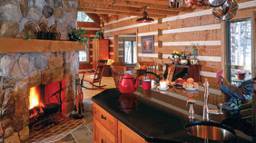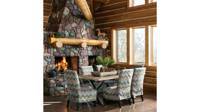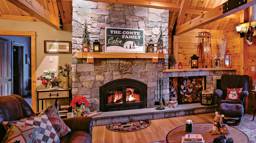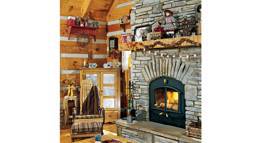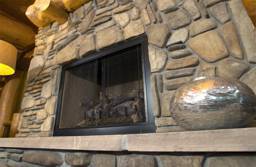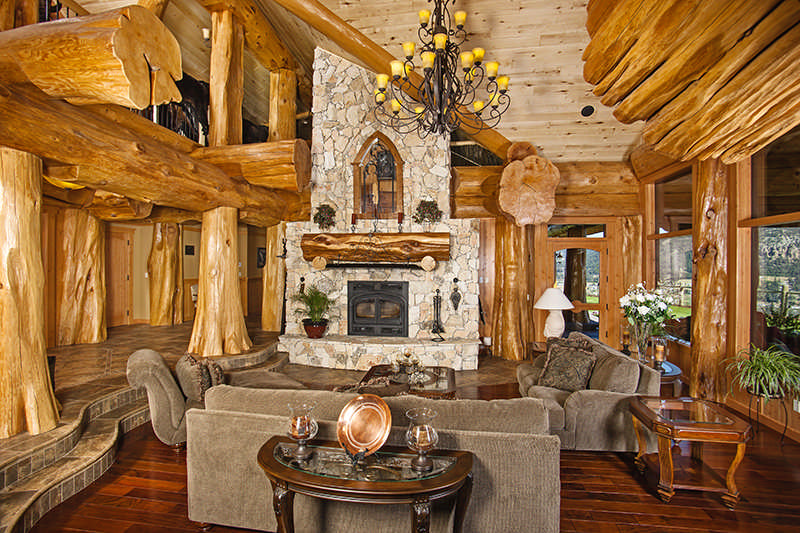
At first glance, the recipe for creating a great hearth in a log home seems all too easy. Start with a fireplace in your great room, add a dash of good friends and family, and you've got a tasty (and toasty) space that warms the body and comforts the soul. But when it comes time to gather the exact physical ingredients–such as specifying the hearth's placement in the room, and its size, shape and type of surroundings, the design decisions become a bit more complex.
While you want a hearth that spreads light and heat with a pleasing presence, you don't want a design that is so robust it dwarfs the rest of the room. Nor should you err on the opposite end of the spectrum with too little eye allure. That would leave you with the feeling you are viewing a candle instead of a cozy fire. And you don't want to simply guess on these design matters, since correcting any mistakes will be difficult and costly once the fireplace is installed. Fortunately, the pros have a few strategies to help you serve up an inviting fire with all the right-sized trimmings. Here are the six design recipes to cook up a fabulous hearth.
1. Pick a Practical Hot Spot
Start by deciding where your hearth should go within your floor plan. Choose an area that is as practical as it is aesthetically pleasing. "Typically there are three competing activities in a great room–the view, the fireplace and the TV," says architect Bill Roseberry of Sunlit Architecture in Crested Butte, Colorado. "Ideally you opt for a design that is sympathetic to all three."
To help you figure the best place for your hearth, experts recommend you visit your home site and use a tape measure, stakes and string to create the exact parameters of your home. This way you'll be better able to envision where the hearth should go and how its use will relate to the view, your entertainment needs and a host of other activities.
Next, you need to determine whether the hearth will fit inside or outside the exterior wall. In past times, some designers would conserve interior floor space by installing a wood-burning fireplace and chimney in a chase projecting outside an exterior wall. But many designers, as well as the Hearth, Patio and Barbecue Association (HPBA), discourage this configuration today. They say it can lead to problems, including poor energy efficiency, "back drafting" and smoke leaking back into the home.
Another configuration that is falling out of favor: flanking a fireplace and chimney with windows. "This was used to incorporate the view and the fireplace. But since you're using the fireplace mainly at night, your windows turn into giant mirrors," says Bill. Today most experts suggest you put your hearth on an inside wall, often using it as a divider between rooms. With this in mind you essentially have three placement options; in a corner or, because rooms are rarely perfectly square, on a long or short wall.
2. Choose Fuel and Vent Options
The fuel you choose and its venting requirements will have an impact on your hearth, since these factors also will influence placement and construction costs. Depending on the fuel used, hearths are vented in three ways: natural draft (also known as B-vent), direct vent and vent-free.
- Natural-draft venting uses a chimney (constructed from cylindrical metal or bricks and mortar) to exhaust smoke. It's most often used with coal or wood-fired hearths. Because the chimney has to extend through the attic and roof, natural draft is the most expensive option to construct.
- Direct vent is a far less expensive option, but it can only be used with gas-fired hearths. As the name implies, a direct-vent chimney channels exhaust directly from the hearth through an exterior wall using a short cylindrical metal chimney and vent on the exterior wall.
- Vent-free units burn so efficiently that they eliminate the need for venting (though they're only allowed in certain regions). This means you can avoid the cost for a chimney and put a unit anywhere in a room. They're also only used with gas hearths. Check with your local building department to find out what fuel and venting options are permitted in your region.
3. Balance Size and Power
The size and shape of the opening in your hearth has to fit the room and vice versa. This achieves a balance in spatial design and ensures your room is thoroughly heated (or not overheated). The narrower the wall in width, the narrower and taller your hearth opening should be.
Choose a wider opening if you're building your hearth on a wall of longer width. This will help balance the look of your room. If you are using the hearth as a heat source rather than for ambiance, you will need to consider the size of the area you intend to heat. "From a BTU standpoint, take a look at the cubic square feet of the room. So many consumers base their choice on the amount of square footage a unit will heat," advises Chris Maxson, president of Acucraft Fireplaces in Big Lake, Minnesota. This especially is important if you're buying a pre-fabricated hearth that has a heat rating. "The heat rating is typically based on an 8-foot-high ceiling. If you have a 22-foot-high ceiling, you will have very different heating needs," Chris says.
The height of your hearth opening above the floor often is a matter of local building codes and personal preference. The average height would be 12 to 14 inches from the floor to the bottom of the hearth opening, which allows you to install a seating area in front of your hearth.
4. Calculate Proportions
Historically, the size of a brick and mortar fireplace was often a reflection of the wealth and status of its owner. In that sense, not much has changed. That's why masons can create nearly any size fireplace. However, they do work within certain parameters for aesthetic reasons as well as practical reasons for venting.
For a fireplace with a formal opening, the height of the opening should be 60 percent of the width–or almost half as high as it is wide, explains Walter Moberg of Moberg Fireplaces in Portland, Oregon. "With higher ceilings you can get into some more classical arrangements where the opening is nearly square, so the height is closer to 80 percent of the width."
Be aware that a traditional fireplace will cost three to 10 times the amount of its factory-built counterpart, which ranges from $3,000 to $6,000. Adding custom glass doors to the fireplace opening, which is recommended to reduce heat loss up the chimney when you're not using the fire, can add anywhere from $2,000 to $5,000 to the cost.
5. Create a Focal Point
While a fireplace or stove warms you on cold winter nights, it's the surround that transforms the hearth into a year-round architectural focal point. Stone is the most popular surround material in log homes, since it lends an organic counterpoint to the grain and texture of the wood. The size of the stone surround is as equally important to architectural balance as the size of the hearth opening and the overall size of the room.
A larger surround can make a smaller opening seem larger or a smaller surround can make a larger opening seem less imposing. Designers recommend the width of a stone surround be from one-half to one-third the entire width of the wall or 110 to 120 percent of the size of the fireplace or stove opening.
When it comes to the actual stone, you have three options: real stone, stone veneer or concrete aggregates that replicate the look of real stone.
- Real fieldstone is the most expensive, not just for masonry work, but for the additional costs involved in shoring up the foundation. The stone is so heavy you'll need to install footers to support the weight.
- A stone veneer is made from real stone that has been quarried and precut to uniform dimensions. It can be applied over standard wood framing. The advantage is you get the appeal of real rock without the additional costs. Also, the installation cost for this material is around a third of real stone.
- Concrete aggregates, like those from Cultured Stone, can be difficult to tell apart from the real thing and they cost less than a quarter of real stone. These, too, are applied over standard framing.
6. Top it Off
No hearth is complete without a mantel. But at what height will it look right? Designers recommend installing the horizontal plane of the mantel a little more than halfway up the wall, to keep its height in proportion to the volume of the room. Keep in mind that these design strategies are just a starting point in creating the hearth of your dreams.
"There is only one rule when it comes to sizing a hearth," says Roger Sanders, president of Fireside Spa & Patio in Bend, Oregon. "Beauty is in the eye of the beholder. It comes down to what looks good to you."
See also: Six Log Home Fireplace Styles





